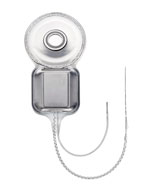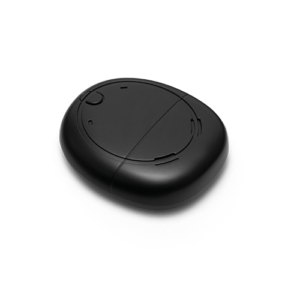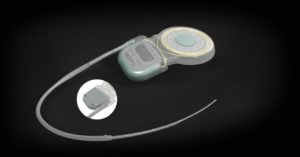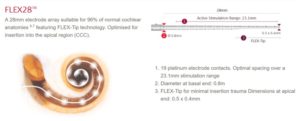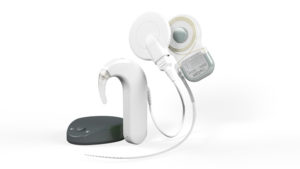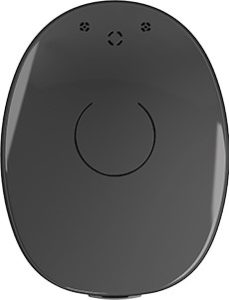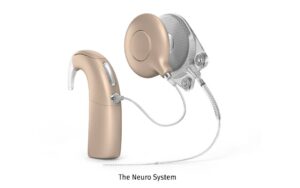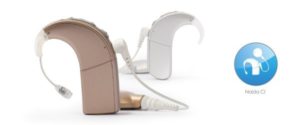
A cochlear implant is a device where an electrode is placed into the inner ear, traditionally used to manage bilateral severe sensori-neural hearing loss. A sound processor (visually like a standard behind the ear hearing aid) is then worn and communicates to the implant via a magnetic connection.
They have revolutionised the management of severe hearing loss not only in children but for thousands of adults.
The procedure itself is now routine surgery, which is low risk and involves an overnight stay in hospital.
There are now a number of high quality implants, with a range of electrodes and processors that allow choice for patients and flexibility for different degrees of hearing loss and anatomical variations.
A great change in philosophy as well as clinical practice is the goal to preserve the normal structure of the inner ear. This is especially the case for patients with some residual hearing, but is employed for all patients undergoing cochlear implantation. If the normal structure of the inner ear is maintained this minimises the impact on balance, maximises the chance of preserving hearing and at least theoretically preserves the possibility for further inner ear therapies.
This is being achieved by both the development of thinner, less traumatic electrodes as well as by advances in surgical techniques and the use of perioperative medications. One of the great controversies surrounds the balance between complete cochlear coverage with a slightly longer electrode, but with a higher rate of losing residual hearing. Tailoring electrode choice to the specific cochlear both anatomically and in the near future genetically with hopefully allow us to achieve the correct balance.
When to consider a cochlear implant in adults if despite optimally powered and tuned hearing aids a person is:
- Unable to follow the TV without captions/teletext
- Can only hear on telephone with well known speakers
- Worried about losing their job
- Avoids social situations
- Unable to follow a group conversation
- Unable to hear in noisy environments
- Concerned about social isolation loneliness or depression
When these above criteria are met an extensive work-up is required involving both an ENT surgeon and an audiologist.
In recent years the criteria for implantation has significantly expanded. Initially only people with bilateral profound hearing loss were considered for implantation. Due to improved techniques in cochlear implant surgery and improved technology people with a degree of residual hearing will in fact get a better hearing result from an implant. This has become even more apparent with the introduction of hybrid devices. Classically these cochlear implants benefit those who have residual low frequency hearing, but a rapid fall off at higher frequencies, the so called ski-jump hearing loss pattern.
Assessment for cochlear implantation
This involves a close working relationship with an audiologist and the surgeon in conjunction with the patient and their family. For older children and adults, the assessment involves detailed audiologic test to determine the true hearing levels with maximally tuned hearing aids in varying hearing conditions. It is important to test not only the volume of sounds heard but also the quality of the sound. This is reflected in speech discrimination scores, ie the ability to understand the spoken word. There are a select group of audiology practices that have the expertise and experience to conduct this assessment and also manage the post-operative retraining. Please let us know if you require any further information in this regard.
A detailed examination of the patient as well as imaging of the ear and brain are important to identify any anatomical abnormalities. Often formal balance assessment and testing is also conducted.
Once these assessments have been performed a thorough discussion is then carried out to determine the realistic benefits and the rare but possible side effects.
Please do not hesitate to contact us for more information or to organise a discussion regarding your hearing difficulties.
Advances
There is a wide range of implantable electrodes that are designed to accomodate the underlying anatomy as well as the degree of residual hearing. This helps facilitate the atraumatic surgical insertion techniques that are employed.
In children with severe to profound hearing loss the aim is to implant as soon as is practicable, often well before the first birthday. Detection of children with severe hearing loss has been made possible by the introduction of the State Wide Infant Screening Programme (SWISH).
Bilateral implantation is now also routine. In young children this is often performed concurrently. In adults the general principle is to implant the worst hearing ear first, and to implant the second ear when the first implanted ear has been optimised.
Single unit processors are now available with improved cosmesis and for some improved functionality. The cochlear coorporation processor is the Kanso and boasts 2 microphones, and the Medel corporation processor is called the Rondo.
There is ever expanding improvements in the external processors, and also integration wirelessly with other electronic devices including phone and TV. Perhaps even more importantly integration with a hearing aid in the other ear is now possible, and stresses the importance of the audiologist to have the ability to map both the cochlear implant as well as fit and optimise standard hearing aids.
The most exciting recent advance is the pleasing results being obtained in insertion of cochlear implants for single sided deafness. This is especially the case where there is significant tinnitus. It is the only reliable method to regain true binaural hearing. This indication has now achieved TGA approval for both the Cochlear and Medel Devices.
Which Implant to Choose
Constant advances are being made to both the internal implantable devices and the external sound processors, and competition between the major companies is a fantastic situation for recipients. There are many individualised factors to consider, and the following links provide further information.
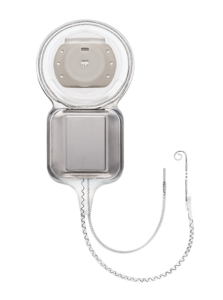
CI 632. Slim Perimodiolar Electrode
The width of the profile series implants
MRI safety continues to improve. The new 6 series has a flipable magnet allowing up to 3T MRI without either removing the magnet nor even a head bandage,
The new Cochlear Kanso 2. A single unit processor that sits off the pinna, with dual microphones
Diagram illustrating deepest insertion using a Flex28 electrode
The new Medel SYNCHRONY CI System features the water-resistant SONNET Audio Processor, RONDO, and the SYNCHRONY Cochlear Implant
Rondo 2. The new single unit processor from Medel
www.oticonmedical.com/cochlear-implants
The new hiFocus mid-scala electrode and Naida speech processor
Other Links
It is certainly worth reading a recent article published in the New England Journal of Medicine (NEJM), Cochlear Implants – Science, Serendipity, and Success. September 26, 2013.
British Cochlear Implant Group Recommendations for users. This is a useful resource outlining sensible recommendation for users to follow after implantation.

